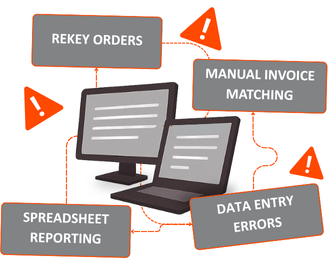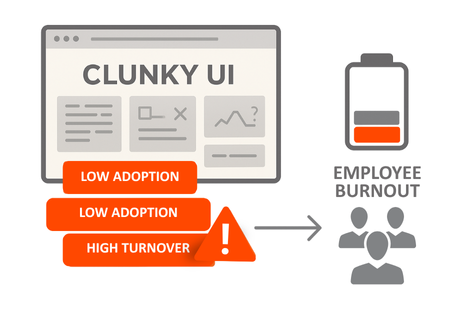The Real Costs of Legacy Dealer Management Systems—
and Why It’s Time to Upgrade

Legacy dealer management systems may seem 'good enough'—but the truth is, they’re costing construction equipment dealers far more than they realize. From wasted time and disconnected tools to rising security risks, these outdated platforms are holding your business back.
If your current platform was built decades ago, it may not just be outdated. It may be actively holding your dealership back.
Here are six ways legacy systems are costing more than you think.
1. Time Wasted on Manual Workarounds
Legacy systems are rarely automated. Instead, your team spends time working around limitations. They may be retyping orders, tracking invoices offline, or pulling reports from multiple sources.
This slows down your business, increases the risk of errors, and adds hours of unnecessary work to already busy teams.

2. Limited Visibility Into Business Performance
Older DMS platforms often lack real-time reporting or dimensional analysis. That means you cannot easily see profitability by location, brand, or equipment type, especially if you operate across multiple stores.
When leadership doesn’t have access to timely data, it delays decision-making and reduces your ability to respond quickly to changes in the market.
3. Poor User Experience and Staff Burnout
Outdated systems are frustrating to use. Clunky interfaces, confusing workflows, and long learning curves make daily tasks harder than they should be.
For departments like finance, service, and operations, this often results in low adoption and high turnover. New employees take longer to train, and experienced team members feel the strain of inefficient tools.

4. Disconnected Tools and System Sprawl
Many legacy systems rely on bolt-on tools for CRM, quoting, rental management, or texting. These tools are usually not well integrated.
As a result, teams are forced to switch between platforms, enter the same information multiple times, and manually sync data. This creates delays, data inconsistencies, and a disjointed customer experience.
5. Security Risks and System Vulnerabilities
Many older platforms weren’t built for today’s cybersecurity environment. Updates can be difficult, and remote access often relies on VPNs or outdated protocols.
Dealers running legacy systems are more exposed to:
- Known software vulnerabilities
- Ransomware attacks
- Business interruptions from system failures
Recent industry-wide breaches have made one thing clear: security is no longer optional. Modern systems must be designed to stay secure and up to date.

6. Lack of Innovation and Vendor Stagnation
Many legacy software vendors are no longer actively improving their products. Updates are infrequent, cloud capabilities are limited, and modern features are slow to arrive or entirely missing.
This leaves your business stuck with tools that no longer align with your growth plans, forcing your team to create manual workarounds instead of taking advantage of automation.
Frequently Asked Questions
A legacy DMS is an older, often on-premise software platform used to manage dealership operations. These systems were typically built decades ago and lack the automation, integration, and real-time data capabilities that modern businesses need.
Because they aren’t built for automation. Teams often retype orders, manage spreadsheets manually, or use disconnected tools. This results in duplicate work, slower processes, and a higher risk of errors.
Legacy platforms usually don’t offer real-time reporting or detailed performance insights. This makes it difficult for leadership to see key metrics like profitability by store or brand, which slows down decision-making.
Disconnected tools force teams to switch between platforms and re-enter the same data in multiple places. This creates delays, data inconsistencies, and a fragmented customer experience.
Yes. Many legacy systems were not designed with modern cybersecurity in mind. They often rely on outdated protocols and are more exposed to risks like ransomware, data breaches, and system failures.
Some legacy software vendors have stopped investing in their products. Updates are infrequent, cloud capabilities are limited, and modern features are often missing altogether.
Technical debt is the ongoing cost of using outdated systems that require more time and resources to maintain. Over time, this debt slows growth and limits your ability to adapt as your business evolves.
Modern dealer platforms like Flyntlok and Sage Intacct offer automation, cloud-based access, real-time reporting, and better integration across your entire dealership. These tools are designed to improve efficiency and support long-term growth.
Is It Time to Make the Switch?
If any of these signs sound familiar, it may be time to re-evaluate your DMS. Modern dealer platforms are helping equipment dealerships reduce friction, work more efficiently, and gain better visibility across their operations.
You do not have to stay stuck in systems built for another era. There is a better way to run your business.
Ready to explore what a modern DMS looks like?
